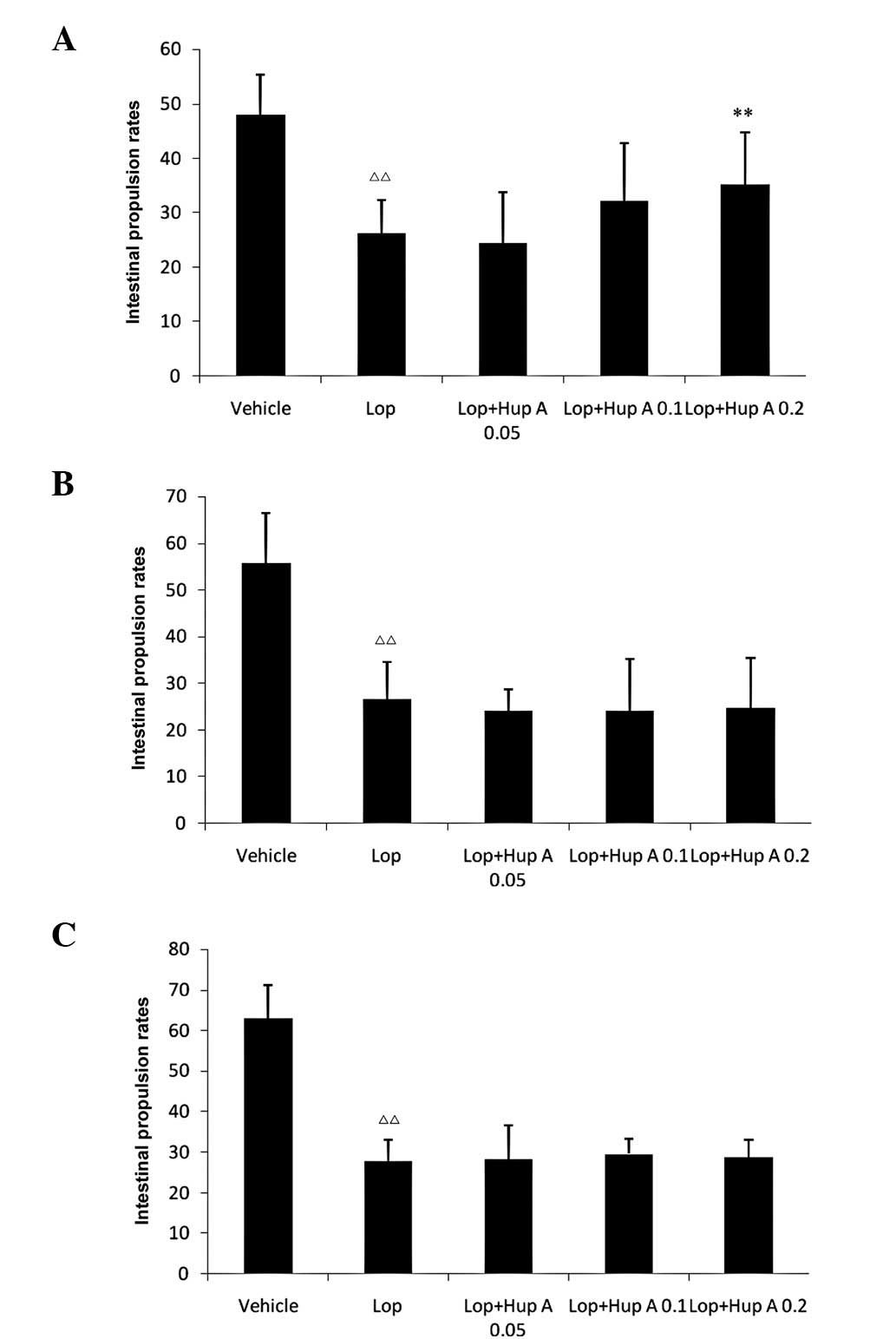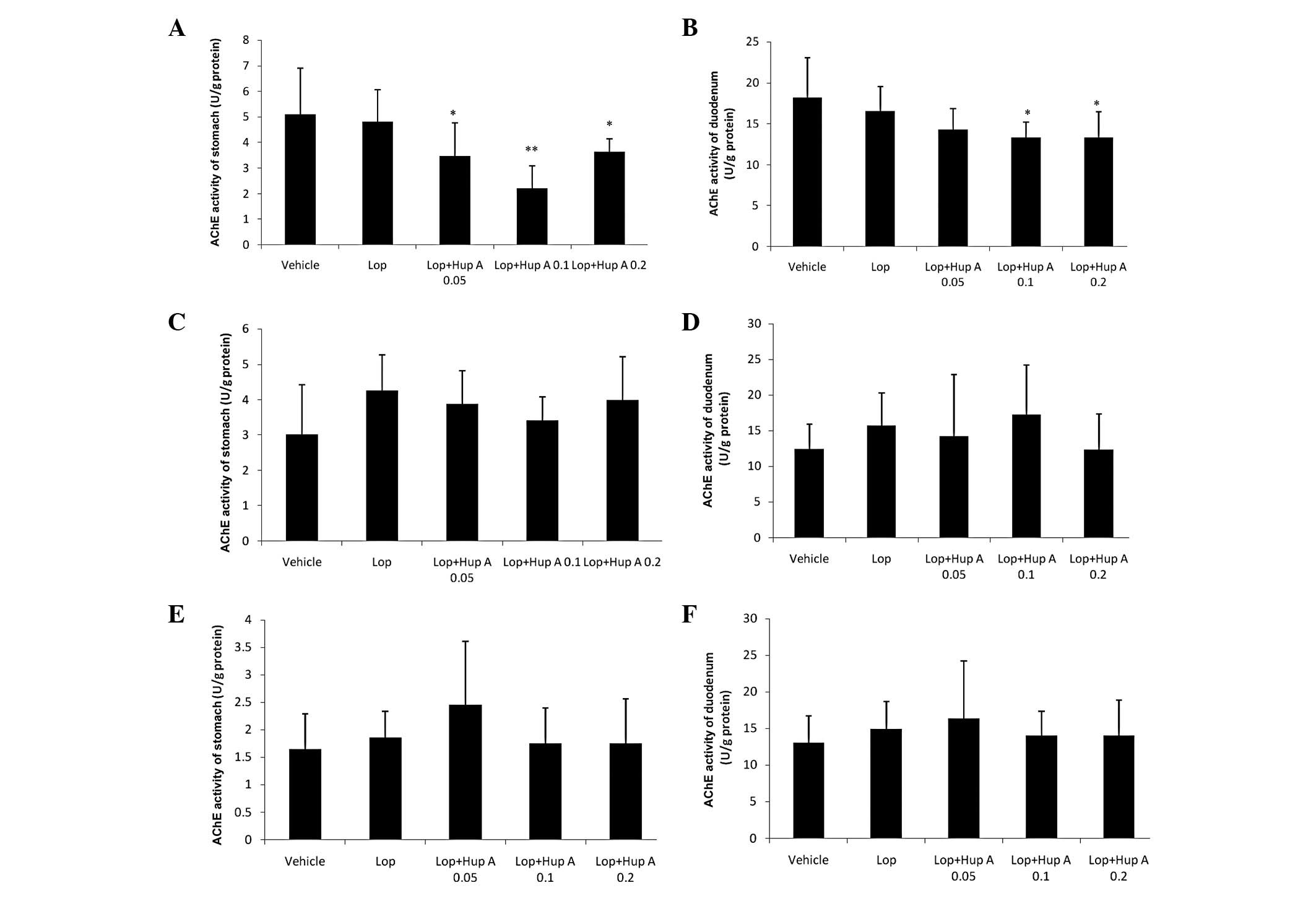The effects of huperzine A on gastrointestinal acetylcholinesterase activity and motility after single and multiple dosing in mice
- Authors:
- Published online on: January 4, 2013 https://doi.org/10.3892/etm.2013.883
- Pages: 793-796
Abstract
Introduction
Alzheimer’s disease (AD) is the most common form of dementia. Currently, there is no cure for the disease, which worsens as it progresses and eventually leads to mortality. The cause of the majority of Alzheimer’s cases remains unknown. The most significant hypothesis attempting to explain the cause of the disease is the cholinergic hypothesis (1), which proposes that AD is caused by reduced synthesis of the neurotransmitter acetylcholine.
Acetylcholinesterase inhibitors (AChEIs), including tacrine, rivastigmine, galantamine and donepezil, are currently used to treat the cognitive manifestations of AD (2). However, AChEIs may cause a broad spectrum of adverse events in the gastrointestinal system, including nausea, vomiting and diarrhea (3,4). These side-effects arise in ∼10–20% of users and are mild to moderate in severity. These adverse events, which force a number of patients to stop taking AChEI agents, are generally recognized to be a result of parasympathetic nervous system activity. AChEIs ameliorate dementia by inhibiting acetylcholinesterase (AChE) in the central nervous system (5,6).
The AChEI huperzine A, an alkaloid isolated from Huperzia serrata, has been used in the treatment of the cognitive deterioration associated with AD in China (7). It also results in nausea, vomiting and diarrhea, similar to other AChEIs. To date, it is not known how quickly these side-effects become tolerated. The present study aimed to observe the effects of huperzine A on gastrointestinal motility and AChE activity in mice, following varying periods of administration, to provide guidance to doctors on how to use huperzine A so as to attenuate adverse events.
Materials and methods
Chemicals and instruments
Huperzine A tablets were obtained from Henan Tailong Pharmaceutical Co., Ltd. (Henan, China). Loperamide hydrochloride capsules were obtained from Xian Janssen Pharmaceutical Ltd. (Xian, China). All other chemicals and reagents used in this study were of analytical grade.
Animals
Male Swiss mice weighing 20±2 g were obtained from the Experimental Animal Center of Luye Pharmaceutical Company (Shandong, China). All experimental procedures carried out in this study were performed in accordance with the guidelines for the care and use of laboratory animals of Yantai University and were approved by the Ethics Committee of the university. All mice were housed in diurnal lighting conditions (12 h/12 h) and allowed free access to food and water.
Gastrointestinal motility
Fifty mice were randomly divided into five groups (10 animals per group): a vehicle group, a loperamide group (Lop), a loperamide + 0.05 mg/kg huperzine A group (Lop+Hup A 0.05), a loperamide + 0.1 mg/kg huperzine A group (Lop+Hup A 0.1) and a loperamide + 0.2 mg/kg huperzine A group (Lop+Hup A 0.2). The animals in the vehicle and Lop groups received intragastric administration of solvent, while huperzine A was administered to the animals in the Lop+Hup A groups. Each mouse was fasted for 12 h prior to the gastrointestinal motility test. After single and multiple dosing (7 or 28 doses, one dose per day), the mice received an oral administration of 4 mg/kg loperamide, 1 h after the last administration of huperzine A. Thirty minutes later, each mouse received an oral administration of 0.2 ml charcoal meal. After 15 min, each animal was sacrificed and the intestinal distance of movement of the charcoal meal from the pylorus was measured and expressed as a percentage of the distance from the pylorus to the cecum.
AChE activity assays
Following the gastrointestinal motility test, the brain, stomach and duodenum of mice in each group were separated on ice and homogenized with ice-cold saline to form a 10% (w/v) homogenate. AChE activity was determined based on the methods of Ellman et al(8). Briefly, a reaction mixture containing 955 μl sodium phosphate (0.1 M, pH 7.4), 25 μl 5,5′-dithiobis(2-nitrobenzoic acid) (DTNB; final concentration, 0.5 mM) and 10 μl homogenate was incubated for 5 min at 37°C, then 10 μl 0.1 M acetylcholine iodide (final concentration, 1 mM) was added. After incubation for 15 min at 37°C, the absorbance was measured at 412 nm at room temperature. AChE activity was expressed as U/g protein.
Statistical analysis
Data were analyzed using one-way analysis of variance (ANOVA) with Bonferroni post hoc test for multiple t-tests. A value of P<0.05 was considered to indicate a statistically significant difference. All data in this study were expressed as mean ± standard deviation.
Results
Effects of huperzine A on gastrointestinal motility
Following a single dose of huperzine A, the intestinal propulsion rates were significantly increased; however, following the administration of multiple doses (7 or 28 doses, one dose per day), no significant differences in intestinal propulsion rates were observed compared with those in the Lop group (Fig. 1).
Effects of huperzine A on AChE activity of gastrointestinal tissues in mice
Following a single dose of huperzine A, AChE activity in the stomach and duodenum was significantly inhibited; however, following the administration of multiple doses (7 or 28 doses, one dose per day), no significant differences in AChE activity were observed compared with those in the Lop group (Fig. 2).
Effects of huperzine A on AChE activity in the brain
Following single- or multiple-dose administration of huperzine A, the AChE activities in the brains of the mice were significantly inhibited compared with that in the Lop group (Fig. 3).
Discussion
AChEIs have been approved for the symptomatic treatment of AD for approximately twenty years. However, the side-effects associated with increased cholinergic activity, particularly in the gastrointestinal system, prevent patients from receiving effective doses of the drug. In addition, the advanced age and frail nature of many patients with AD mean that poor tolerability is a serious concern.
Gastrointestinal motor activity is mainly regulated by the neural and hormonal systems (9). Cholinergic neurons are considered to be the major excitatory neurons involved in gastrointestinal motor activity since the majority of gastrointestinal contractions are markedly inhibited by atropine, a muscarinic receptor antagonist (10,11). Acetylcholine (ACh) is an important regulator of gastrointestinal motility and the inhibition of AChE activity has been reported to enhance gastrointestinal motility (12,13).
In the present study we investigated gastrointestinal motility and AChE activity in the stomach and duodenum following single- and multiple-dose oral administration of huperzine A at therapeutic doses in mice (14,15).
In order to enhance the detection sensitivity of huperzine A on gastrointestinal motility, mice were administered loperamide, an opioid-receptor agonist often used against diarrhea, to slow down the gastrointestinal motility. The results revealed that the AChE activities in the brains of mice receiving single- and multiple-dose huperzine A treatment were significantly reducted, which indicates that the dosage of huperzine A administered would be effective for AD. After a single dose of huperzine A, the gastrointestinal AChE activity was reduced and intestinal propulsion rate was significantly increased, which demonstrates that gastrointestinal side-effects are likely to occur during the initial period of treatment with huperzine A. However, after multiple-dose (7 or 28 doses, one dose per day) administration, no significant differences in gastrointestinal AChE activity and intestinal propulsion rates were observed. These results indicate that huperzine A affects gastrointestinal motility by inhibiting AChE activity, but after multiple-dose administration it is well-tolerated in the gastrointestinal system of mice. The molecular mechanisms explaining how gastrointestinal motility and AChE activity are unaffected by multiple-dose administration require further study.
These findings indicate that the gastrointestinal adverse effects of huperzine A may be well-tolerated relatively quickly and that patients with AD are likely to have minimal gastrointestinal side-effects after taking multiple doses of huperzine A.
Acknowledgements
This study was supported by the Taishan Scholar Project, a project of Shandong Province Higher Educational Science and Technology Program (grant no. J10LF76) and the Foundation for Outstanding Middle-aged and Young Scientists (grant no. BS2011YY061).
References
|
Francis PT, Palmer AM, Snape M and Wilcock GK: The cholinergic hypothesis of Alzheimer’s disease: a review of progress. J Neurol Neurosurg Psychiatry. 66:137–147. 1999. | |
|
Pohanka M: Cholinesterases, a target of pharmacology and toxicology. Biomed Pap Med Fac Univ Palacky Olomouc Czech Repub. 155:219–229. 2011. View Article : Google Scholar : PubMed/NCBI | |
|
Birks J: Cholinesterase inhibitors for Alzheimer’s disease. Cochrane Database Syst Rev. 25:CD0055932006. | |
|
Mimica N and Presecki P: Side effects of approved antidementives. Psychiatr Danub. 21:108–113. 2009. | |
|
Farlow M, Veloso F, Moline M, et al: Safety and tolerability of donepezil 23 mg in moderate to severe Alzheimer’s disease. BMC Neurol. 11:572011. | |
|
Alva G and Cummings JL: Relative tolerability of Alzheimer’s disease treatments. Psychiatry (Edgmont). 5:27–36. 2008. | |
|
Wang R, Yan H and Tang XC: Progress in studies of huperzine A, a natural cholinesterase inhibitor from Chinese herbal medicine. Acta Pharmacol Sin. 27:1–26. 2006. View Article : Google Scholar : PubMed/NCBI | |
|
Ellman GL, Courtney KD, Andres V Jr and Featherstone RM: A new and rapid colorimetric determination of acetylcholinesterase activity. Biochem Pharmacol. 7:88–95. 1961. View Article : Google Scholar : PubMed/NCBI | |
|
Rogers RC, McTigue DM and Hermann GE: Vagal control of digestion: modulation by central neural and peripheral endocrine factors. Neurosci Biobehav Rev. 20:57–66. 1996. View Article : Google Scholar : PubMed/NCBI | |
|
Shiba Y, Mizumoto A, Inatomi N, Haga N, Yamamoto O and Itoh Z: Stimulatory mechanism of EM523-induced contractions in postprandial stomach of conscious dogs. Gastroenterology. 109:1513–1521. 1995. View Article : Google Scholar : PubMed/NCBI | |
|
Furuichi A, Makimoto N, Ogishima M, et al: In vivo assessment of the regulatory mechanism of cholinergic neuronal activity associated with motility in dog small intestine. Jpn J Pharmacol. 86:73–78. 2001. View Article : Google Scholar : PubMed/NCBI | |
|
Iwanaga Y, Miyashita N, Morikawa K, Mizumoto A, Kondo Y and Itoh Z: A novel water-soluble dopamine-2 antagonist with anticholinesterase activity in gastrointestinal motor activity. Comparison with domperidone and neostigmine. Gastroenterology. 99:401–408. 1990. | |
|
Ueki S, Seiki M, Yoneta T, et al: Gastroprokinetic activity of nizatidine, a new H2-receptor antagonist, and its possible mechanism of action in dogs and rats. J Pharmacol Exp Ther. 264:152–157. 1993.PubMed/NCBI | |
|
Wang Y, Tang XC and Zhang HY: Huperzine A alleviates synaptic deficits and modulates amyloidogenic and nonamyloidogenic pathways in APPswe/PS1dE9 transgenic mice. J Neurosci Res. 90:508–517. 2012. View Article : Google Scholar : PubMed/NCBI | |
|
Zhu XD and Tang XC: Improvement of impaired memory in mice by huperzine A and huperzine B. Zhongguo Yao Li Xue Bao. 9:492–497. 1988.(In Chinese). |












